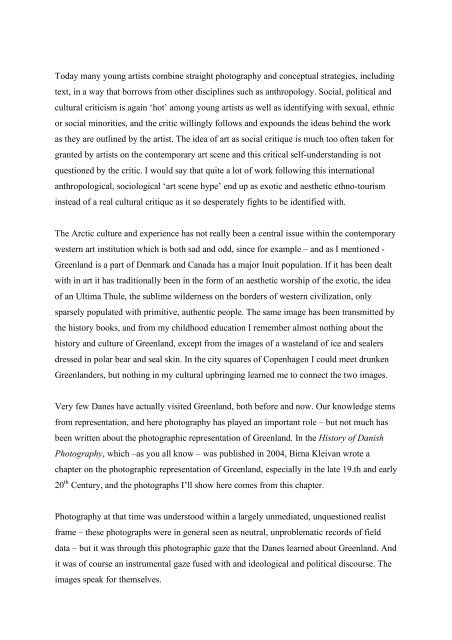Mette Sandbye
Mette Sandbye
Mette Sandbye
You also want an ePaper? Increase the reach of your titles
YUMPU automatically turns print PDFs into web optimized ePapers that Google loves.
2<br />
Today many young artists combine straight photography and conceptual strategies, including<br />
text, in a way that borrows from other disciplines such as anthropology. Social, political and<br />
cultural criticism is again ‘hot’ among young artists as well as identifying with sexual, ethnic<br />
or social minorities, and the critic willingly follows and expounds the ideas behind the work<br />
as they are outlined by the artist. The idea of art as social critique is much too often taken for<br />
granted by artists on the contemporary art scene and this critical self-understanding is not<br />
questioned by the critic. I would say that quite a lot of work following this international<br />
anthropological, sociological ‘art scene hype’ end up as exotic and aesthetic ethno-tourism<br />
instead of a real cultural critique as it so desperately fights to be identified with.<br />
The Arctic culture and experience has not really been a central issue within the contemporary<br />
western art institution which is both sad and odd, since for example – and as I mentioned -<br />
Greenland is a part of Denmark and Canada has a major Inuit population. If it has been dealt<br />
with in art it has traditionally been in the form of an aesthetic worship of the exotic, the idea<br />
of an Ultima Thule, the sublime wilderness on the borders of western civilization, only<br />
sparsely populated with primitive, authentic people. The same image has been transmitted by<br />
the history books, and from my childhood education I remember almost nothing about the<br />
history and culture of Greenland, except from the images of a wasteland of ice and sealers<br />
dressed in polar bear and seal skin. In the city squares of Copenhagen I could meet drunken<br />
Greenlanders, but nothing in my cultural upbringing learned me to connect the two images.<br />
Very few Danes have actually visited Greenland, both before and now. Our knowledge stems<br />
from representation, and here photography has played an important role – but not much has<br />
been written about the photographic representation of Greenland. In the History of Danish<br />
Photography, which –as you all know – was published in 2004, Birna Kleivan wrote a<br />
chapter on the photographic representation of Greenland, especially in the late 19.th and early<br />
20 th Century, and the photographs I’ll show here comes from this chapter.<br />
Photography at that time was understood within a largely unmediated, unquestioned realist<br />
frame – these photographs were in general seen as neutral, unproblematic records of field<br />
data – but it was through this photographic gaze that the Danes learned about Greenland. And<br />
it was of course an instrumental gaze fused with and ideological and political discourse. The<br />
images speak for themselves.

















